Knock-out blow to the US Pacific Fleet, a rapid offensive to seize as much territory as possible, then to sue for peace. It was not his fault that the American carriers happened to be at sea at the time of the attack. Apart from this his plan worked brilliantly in the first six months of the Pacific War - the Philippines, Malaya, Indonesia, Burma all fell. Force Z and the Allied fleet in Indonesia were destroyed. However, Yamamoto was forced to make another, probably over-complicated, plan for attacking the American fleet which met its nemesis at Midway. This was, in part, a victory obtained by American codebreakers. Early in 1943, these codebreakers found out that Yamamoto was on an inspection tour of the Solomon Islands. His “Betty” transport plane was ambushed and shot down by a force of American P-38 Lightning fighters. His body was found in the wreckage. DJL.
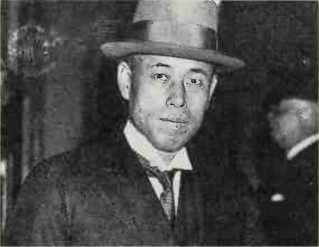
Yamamoto at London Naval Conference
Yamashiro. Japanese battleship. Fuse class. Completed 1917. Sunk in the Surigao Strait action 1944.
Yamashita, Gen Tomoyuki
(1885-1946). Jap. Although, after heading a military mission to Berlin and Rome, Yamashita early in 1941 strongly opposed a declaration of war until the modernization of Japan’s forces was complete, he was in December 1941 given command of Twentyfifth Army for the conquest of Malaya. Japan quickly established air and naval superiority, but on land Yamashita was outnumbered: for his initial landings on December 8 he deployed three divisions (about 62,000 men), opposed by Percival’s c89,000 British and Commonwealth troops. His speedy advance down the Malayan peninsula, relying on infiltration tactics (and facilitated by Allied weaknesses in command) forced Percival’s withdrawal to Singapore Island by January 31 1942. Although now desperately short of materiel and outnumbered by more than two-to-one in men and artillery, Yamashita pressed his attack, forcing Percival’s surrender.
From July 1942, largely because Tojo regarded the “Tiger of Malaya” as a rival, Yamashita was relegated to command of First Area Army in northern Manchuria. Following Tojo’s fall in July 1944, he was appointed to command Fourteenth Area Army in the defence of the Philippines, taking up his post on October 5, only one week before the US invasion of Leyte. Hampered by divided command - he was subject to Terauchi’s Southern Area Army, and had very little control over air and sea operations - Yamashita was forced to weaken the garrison of Luzon to reinforce what he recognized to be a hopeless attempt to hold Leyte (which fell in December). Following the US landings on Luzon, January 9 1945, he aimed to tie down as many US troops as possible for as long as he could, thus delaying the invasion of Japan itself. He ordered that Manila should not be defended - it was held d outrance, nevertheless, by Iwabuchi’s Naval Defence Force - and retreated into the northern highlands, where, lacking all supplies, his men held out until the war’s end.
Within a few weeks of his surrender, on September 2 1945, Yamashita was charged with “war crimes” (notably the atrocities committed by Iwabuchi’s force), tried under MacArthur’s auspices in Manila, and, in a process that many have subsequently acknowledged to have been unfair, condemned to death. He was hanged on February 23 1946. RO’N.
Yamato. Japanese battleship. Intended to counteract US numerical superiority in battleships by size and power, and built in great secrecy, she displaced more than
70,000 tons full load and was armed with 9 x 18.1in guns. With sister Mushashi the largest, most heavily armed battleship built. Sunk by overwhelming and repeated air attack.
Yannina, siege of U912-13). Greece saw in the Balkan Wars the chance to enlarge her territories, not only by the acquisition of Crete, but also by the capture of land in Salonika and Epirus, with its great fortress of Yannina, still possessions of Turkey. She did not therefore join in the armistice signed by the other belligerents on December 3 1912. Greece had already begun a blockade of Yannina in November 1912 and during the winter she ferried troops around from Salonika by sea and began a general assault on March 5 1913. Yannina surrendered on March 6. SKF.
Yarmouth, raid on (November 3 1914). German battlecruisers Moltke, Seydlitz and Von der Tann, plus Bliicher and three light cruisers, bombarded the English port of Yarmouth, opposed by light forces. The Harwich force attempted interception, but only the light cruiser Undaunted made contact although she was recalled as the German force escaped.
Yaunde see cameroons (1914-16).
Yellow Sea, Battle of the (August 10 1904), Russo-Japanese War. A Russian squadron of 6 battleships, 4 cruisers and 8 destroyers, under Adm Vitgeft (killed in the action) sortied from Port Arthur in an attempt to join with the Vladivostok squadron. Intercepted by Togo’s force of 4 battleships, 11 cruisers and 17 destroyers, the Russian squadron was severely mauled (one cruiser sunk) and dispersed, some ships regaining Port Arthur, others making neutral ports where they were interned.
Yeo-Thomas, Wg Commander Forest Frederic Edward (“Tommy”) (1902-64). Br. Brought up at Dieppe, narrowly escaped death in Poland 1920; clerk in Paris; joined raf 1939, commissioned 1941, joined soe 1942. Two important missions into France to coordinate Gaullist resistance, 1943. Arrested in Paris 1944; escaped from Buchenwald.
Yeremenko, Marshal of the Soviet Union Andrei Ivanovich
(1893-1970). Russian. A Red Army “work-horse”, Yeremenko held di-

Mi
Q
Visional commands in Poland, 1939, and the Far East, and army commands at Moscow, Stalingrad and Smolensk (1943). In April-May 1944 he commanded Independent Maritime Front in the successful conclusion, with Tol-bukhin, of the Crimean campaign, then led 2nd Baltic Front in the Courland encirclement of German Army Group North. He commanded Fourth Ukrainian Front during the Czechoslovakian campaign, 1945.
Yezhovshchina. Severe purge of Russian armed forces organized for Stalin by Nikolai Ivanovitch Yezhov (1894-1939), head of his secret police. Every officer of the rank of major or above was imprisoned, briefly at least, with the exception of Stalin’s brother-inlaw Voroshilov.
Yom Kippur War (1983) see arab-
ISRAELI WARS.
Yield, The total energy released by a nuclear weapon in its various forms, blast, heat and radiation. It is usually expressed in terms of the energy release of an equivalent tonnage of tnt, but this can be misleading, as the characteristics of a nuclear explosion are different from those of a chemical one. A fission weapon exploded in the air below about 33,360ft (12,000m) will only give 50 percent of its yield in blast; it is thus the equivalent in “bang” to only half the amount of high explosive. However, the latter does not have the added heat and prompt and delayed radiation effects, respectively 35, 10 and 5 percent of total yield. Moreover, the effectiveness of the weapon is not directly proportional to the yield. EJG. See also
EQUIVALENT MEGATONNAGE.
Y-Gerat see x-gerat.
Young Turks. Political party formed in the last decades of the Ottoman empire aiming at reform by centralization of administration and Ottomanization. They were bitterly opposed in the provinces by Christian and Muslim minorities alike. Risings against Young Turk policies and the massacres that they provoked in Macedonia and Albania in part provoked the First Balkan War.
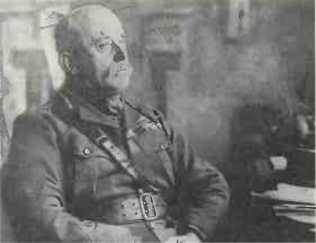
French (Earl of Ypres): c-in-c, bef, 1914
Ypres, Field Marshal Earl of (Sir John French) (1852-1925). Br. During the Gordon Relief Expedition of 1884, French attracted the attention of Buller, who became his influential supporter, and by 1899, as an acting major general, he commanded 1st Cavalry Brigade. The Second Boer War made his reputation as a cavalry commander: he won a resounding victory at Elandslaagte (October 1899) and relieved Kimberley (February 1900) after a spectacular cavalry charge at Klip Drift, ending the war as a lieutenant general. In 1912 he was appointed GIGS (resigning after the Curragh Incident, 1914) and was promoted field marshal in 1913.
In August 1914 French was appointed c-in-c of the bef. His task was made particularly difficult by the failure of the French plan and the exposed position of the BEF, but even so the Mons campaign did him little credit: he got on badly with Lanrezac, commanding the French Fifth Army on his right; quarrelled with Kitchener, Secretary of State for War; and relied too heavily on Henry Wilson, his headstrong Deputy-Chief of General Staff Nevertheless, his personal bravery and charisma helped maintain his reputation within the army, while powerful political supporters opposed demands for his replacement. Certainly, despite his failings as a strategist, he held the BEF together in 1914 as no other general could have done.
Controversy again arose in March 1915, when French blamed his inability to break through at Neuve-Chapelle on the government’s failure to provide sufficient shells, and in April, when he dismissed Smith-Dorrien for alleged failure at Second Ypres. Reluctantly agreeing to cooperate in
Joffre’s autumn offensive, he failed to commit the reserve corps in time at Loos, in September, and was replaced by Haig. He was c-in-c. Home Forces, until May 1918, and then became Lord Lieutenant (de facto military governor) of Ireland until 1921, a difficult task for which he lacked the necessary political acumen. Although undoubtedly temperamentally unsuited to high command, he has been fairly described as the most distinguished British cavalry leader since Cromwell. RH.
Ypres, First Battle of (1914). As a result of the “Race to the Sea” after the Battle of the Aisne, the bef reached the area around Ypres, in Belgian Flanders, at the same time as the German Fourth Army, which contained four newly raised corps of young volunteers, and Sixth Army, transferred from Lorraine. The Germans were now making a belated attempt to secure the Channel Ports whereas the BEF hoped to turn the German right. When the opposing armies clashed on October 19-20 1914, the BEF at first held firm in the Ploegsteert-Messines sector to the south while Haig’s I Corps, trying to advance in the north, near Langemarck, made little significant headway. On October 31 an attack by seven German divisions between Messines and Gheluvelt came near to success. A local counterattack by the 2nd Worcester-shires forced the Germans out of Gheluvelt, in the centre, but Messines Ridge was lost by Allenby’s Cavalry Corps. The arrival of increasing numbers of French troops on the bef’s flanks helped to stabilize the situation until November 11 when the Germans launched another onslaught. The Prussian Guard broke through north of the Menin Road, only to be driven off by a scratch force of cooks, engineers and batmen, joined by the 2nd Oxfordshire and Buckinghamshire Light Infantry. By the end of the battle, around November 22, the bef was left in a dangerous salient at Ypres, with the Germans occupying the dominating ridges to the south and east. The old professional bef, having suffered 58,000 casualties, was effectively destroyed. The Germans also had heavy losses, particularly among the young volunteers. PJS.
Ypres, Second Battle of (1915). On April 22 1915, largely as an experiment but also to divert attention from preparations for their Gorlice-Tarnow offensive, the Germans employed poison gas on the Western Front for the first time, releasing chlorine gas from cylinders against Allied units on the northern flank of the Ypres Salient. The French 45th (Algerian) and 87th Territorial Divisions, between Langemarck and the Yser Canal, retreated in panic, leaving a 4.5 mile (7km) gap on the left of the 1st Canadian Division. However, the subsequent advance by the Germans was cautious and, lacking sufficient reserves to exploit the success, they wasted the opportunity to break through to Ypres itself. The British and Canadians managed to form a patchwork defensive line and despite being subjected to another gas attack near St Julien on April 24 the Canadians, using handkerchiefs soaked in urine or water as improvised respirators, prevented a fatal breach. Even so, starved of French support, British counterattacks failed to recover the lost ground. Smith-Dorrien, commanding the British Second Army, was dismissed after proposing a withdrawal to a shorter line but his successor, Plumer, was permitted to carry out such a movement early in May when it became obvious that substantial French reinforcements were not forthcoming. The Ypres Salient was now less than 3 miles (5km) deep. The Germans delivered further attacks on the Frezenberg and Bellewaarde Ridges during May with little additional gain. In all the bef incurred some 58,000 casualties between April 22—May 31, German losses totalling nearly 35,000. PJS.
Ypres, Third Battle of (1917). Following the capture of Messines Ridge in June, Sir Douglas Haig, the British c-in-c, launched his long-planned Flanders offensive at Ypres on July 31 1917. The immediate objectives were to take the Passchendaele-Staden Ridge and the Gheluvelt plateau, as well as the Roulers-Thourout railway. It was hoped that, with the help of an amphibious landing, the Belgian coast could then be cleared and the Germans denied their U-boat bases at Zeebrugge and Ostend. The main attack was entrusted, not to Plumer’s Second Army - which had taken Messines - but to Gough’s Fifth Army, the change contributing to the delay of the offensive until July 31. Misled into believing that Haig envisaged a rapid breakthrough, Gough set overambitious targets for his units but, in the first three days, the Fifth Army advanced up to 3,000yd (2,750m) on the left, seizing much of Pilckem Ridge. However, August 1917 was unusually wet, and, with the local drainage destroyed by artillery bombardments, the battlefield swiftly turned into a morass. This, coupled with the flexible defence tactics of the Germans slowed the offensive to a crawl. Gough’s failure to secure the Gheluvelt plateau prompted Haig, late in August, to transfer the leading role to Plumer, whose methodical assaults with limited objectives proved much more successful in the sub-battles of the Menin Road Ridge (September 20-25), Polygon Wood (September 26-October 3) and Broodseinde (October 4). The weather deteriorated again and both Plumer and Gough advised halting the offensive, although Haig persisted. On November 6
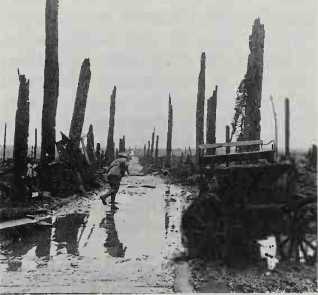
Desolation at Passchendaele, 1917
The Canadian Corps finally took the village of Passchendaele, a name often popularly applied to the whole battle, in which both sides incurred approximately
250,000 casualties. Despite advancing about 5 miles (8km), the British had achieved few of their original strategic objectives. The Third Battle of Ypres, during which men drowned in liquid mud, has since become symbolic of the horrors of World War I. PJS.
“Y” Ravine. Natural feature near Beaumont Hamel on the Somme. A British objective on July 1 1916, finally taken November 13 1916.
Yser, Battle of the. Following the fall of Antwerp on October 10 1914, the Belgian Army withdrew to the line of the River Yser from Dixmude to the coast north of Nieuport. The position was held by five Belgian divisions and a French Marine brigade. Declaring this to be the last line of Belgian resistance. King Albert refused to leave it to join the manoeuvres inland as both sides strove to outflank each other in the “Race to the Sea”. Subsequent events justified his decision for, on October 18, Belgian outposts east of the Yser were driven back by elements of reconstituted German Fourth Army, commanded by Duke Albrecht of Wiirttemberg. Aiming to break through to the Channel ports, the Germans continued to attack on October 19 and 20 but were repulsed at Dixmude and also at Nieuport, where they were heavily shelled by British and French warships. On October 21 Foch sent the French 42nd Division to reinforce the vital Nieuport sector, though the Germans secured a bridgehead across the Yser at Tervaete and, with the aid of 42cm howitzers, launched several more attacks on Dixmude, which was now in danger of being outflanked. By noon on October 30 the Germans had advanced south of Nieuport, taken Ramscapelle and gained a foothold in Pervyse. However, the Belgians opened sluice gates to flood the area east of the railway enbankment between Nieuport and Dixmude. This forced the Germans to halt their attacks and to concentrate instead on the sector around Ypres. PJS.
Y Service. Secret signals teams who listen to enemy wireless traffic, passing available data to relevant operational staffs, providing raw material for decipher and maintaining traffic analysis - observing location and activity of w/t and r/t stations.
Yugoslavia, German invasion of
(April 6-17 1941). Carried out by Twelfth Army (List) to secure Hitler’s southern flank before his invasion of Russia. Yugoslav resis-


Tance, although lasting only 11 days, imposed significant modifications to Hitler’s plans for 1941.
Yugoslavia, British operations in
(1943-1945). Initially, British missions worked with Mihailovich’s Chetniks, and with Tito’s Partisans. By the beginning of 1944, all support was withdrawn from the former, who had become more interested in attacking Tito’s Communists than the Germans. Military support to the Partisans was provided by the British Balkans Air Force (Elliot), and by Land Forces Adriatic (Davy). Apart from continuous air support, supply dropping, casualty evacuation and coastal raiding, the major operations carried out were: i) (June-September 1944) raids on the German-held Dalmatian islands of Brae, Korcula and Solta;
Ii) (September 1944) concentrated air action against German withdrawal routes through Yugoslavia;
Iii) (October 1944—January 1945) “Floyd Force”, composed of British artillery, engineers and commandos, sent to Dubrovnik to assist in trapping the isolated XXI German Mountain Corps withdrawing from Albania. Due to Partisan suspicion of British motives, the force’s full potential was not exploited, and the Germans escaped, although sustaining heavy losses from British attacks, iv) (February 1945) establishment of an advanced air base at Zadar to support the final offensive by Fourth Yugoslav Army (Drapsin) towards Trieste in March-April 1945, and as an emergency airfield for strategic bombers attacking Central European targets. WGFJ.
Yugoslavia, German counterPartisan operations in (November 1941-May 1944). Six offensives were launched by c-in-c South West (von Weichs) against Tito’s Partisans: first, November 1941; second, April 1942; third, November 1942; fourth, January 1943; fifth. May 1943, during which Tito was wounded; and sixth, October 1943-January
1944. All failed to achieve decisive results.
With the capitulation of Italy in September 1943, Tito was able to arm his Partisans with equipment taken from the Italian divisions of the Axis occupation forces, creat-
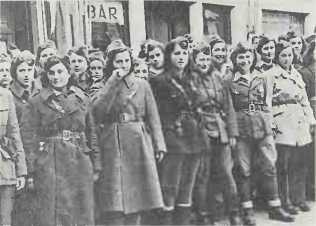
Yugoslav partisan women fighters
Ing the Yugoslav National Liberation Army. In May 1944, von Weichs mounted an operation using SS paratroopers to capture Tito in the caves at Drvar. Tito escaped with Allied assistance to the island of Vis, returning to the mainland three months later under Russian auspices as the Soviet armies approached Belgrade, which fell on October 20. Instead of mounting a seventh offensive against the Partisans, von Weichs had to use his resources to keep open routes for German forces in Greece and Albania, withdrawing northwards to avoid being cut off by the Russians. WGFJ.
Zandvoorde. Village southeast of Ypres, lost to the Germans on October 30 1914, after a gallant
' defence by the British Household Cavalry. It was finally retaken by the British 35th Division on September 29 1918.
Zanussi, Brig Gen Giacomo
(1894-1966). Italian. Emissary at negotiations for Italian capitulation, 1943.
Zeebrugge raid (1918). From early in World War I, German U-boats and destroyers from Zeebrugge and Ostend threatened Allied shipping in the Channel and North Sea. Their permanent base was some 7 miles (11km) inland at Bruges, connected to Zeebrugge and Ostend by canals. Plans for amphibious assaults on the Belgian ports, first suggested by Rear Adm Sir Reginald Tyrwhitt (18701951), were enthusiastically espoused by Vice Adm Roger Keyes, head of the Naval Plans Division, and Commander, Dover
Patrol, January 1918.
Keyes assembled and trained, in secrecy, a force of some 1,000 Royal Navy volunteers and 700 Royal Marines. Motorboats and launches would occupy the shore batteries with mock attacks and lay smokescreens around the harbour; a 900-strong landing and demolition force would storm the strongly-fortified Zeebrugge “mole” (the sickle-shaped pier protecting the harbour); three concrete-filled blockships (old light cruisers Iphigenia, Intrepid and Thetis) would be scuttled in the canal entrance. A simultaneous assault would be made at Ostend.
An initial attempt on the night of April 11-12 was abandoned when adverse winds dispersed the smokescreens. The second attempt was made on April 22—23. Under heavy fire from shore batteries, the old submarine C.3 was detonated under the viaduct connecting the mole to the shore as landing parties from the cruiser Vindictive (specially fitted with landing ramps and with supporting armament including flame-throwers and mortars) and ferries Iris and Daffodil fought desperately with the mole’s 1,000-strong garrison. The blockships’ crews were taken off by launches after triggering delayed-action scuttling charges. Lasting for just over one hour, the raid cost 214 killed and 383 wounded.
The Germans opened channels around the blockships at Zeebrugge within a few days. Nor did a further operation at Ostend on May 9-10 seriously hamper German warships. As a morale-booster, the Zeebrugge-Ostend raids were a tremendous success, reflected in the award of 11 Victoria Crosses and 209 lesser decorations to those taking part. RO’N.
British blockships sunk at Zeebrugge
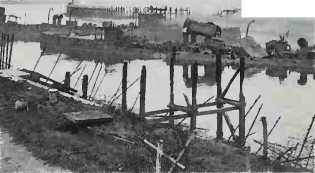




 World History
World History









